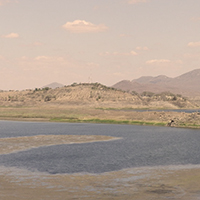Influence of submerged macrophytes on phosphorus in a eutrophic reservoir in a semiarid region
Influence of submerged macrophytes on phosphorus

All claims expressed in this article are solely those of the authors and do not necessarily represent those of their affiliated organizations, or those of the publisher, the editors and the reviewers. Any product that may be evaluated in this article or claim that may be made by its manufacturer is not guaranteed or endorsed by the publisher.
Authors
Phosphorus (P) is the main nutrient responsible for the harmful effects caused by the enrichment of aquatic systems, and submerged macrophytes play an important role in this process, since they can both remove and release this nutrient in environmental compartments. The present study aimed to evaluate the influence of submerged macrophytes on P in the water, sediment, and water-sediment interface in a eutrophic reservoir in a semiarid region and to evaluate the relationship between the concentration of this nutrient in macrophyte tissue and that available in the different compartments. Were performed ten collection campaigns, in three reservoir locations: at the entrance of the Paraíba River; in the intermediate area between the river entrance and the dam and at the dam. We observed a difference in the P concentration inside and outside macrophyte banks, and this difference was determined by the abundance and intensity of macrophyte growth and decomposition. In sites with extensive vegetation banks and where decomposition was more intense, macrophytes released P to the water-sediment interface and sediment compartments. By contrast, in sites with smaller vegetation banks and where macrophytes did not show reduced abundance, P was removed from these compartments. The entry of new water originating from river water transfer was an important modifying factor of the physical and chemical characteristics and macrophyte abundance. The zone where the river enters the reservoir was the area most affected by the water transfer. The macrophyte decomposition in this zone resulted in the highest P concentration in the water-sediment interface and sediment compartments, which demonstrates the importance of macrophytes in the fertilization of water bodies and, consequently, in the eutrophication process. In turn, in the dam zone, where the macrophyte banks were more stable and without large variations in abundance, P was removed from the compartments. A relationship between P in macrophyte tissue and that available in the environment was observed, particularly at the water-sediment interface, indicating that this compartment was the main P source for these plants, which demonstrated that these plants store higher amounts of P in nutrient-rich sediment and water, functioning as an indicator of the nutritional status of a reservoir.






